Emanuele Peschiera
On Optimizing Time-, Space- and Power-Domain Energy-Saving Techniques for Sub-6 GHz Base Stations
May 21, 2025Abstract:What is the optimal base station (BS) resource allocation strategy given a measurement-based power consumption model and a fixed target user rate? Rush-to-sleep in time, rush-to-mute in space, awake-but-whisper in power, or a combination of them? We propose in this paper an efficient solution to the problem of finding the optimal number of active time slots, active antennas, and transmit power at active antennas in a multiple-input multiple-output (MIMO) orthogonal frequency-division multiplexing (OFDM) system under per-user rate and per-antenna transmit power constraints. The use of a parametric power consumption model validated on operator measurements of 4G and 5G BSs enhances the interpretation of the results. We discuss the optimal energy-saving strategy at different network loads for three BS configurations. Using as few BS antennas as possible is close to optimal in BSs not implementing time-domain power savings such as micro-discontinuous transmission ({\mu}DTX). Energy-saving schemes that jointly operate in the three domains are instead optimal when the BS hardware can enter time-domain power-saving modes, with a tendency for rush-to-mute in massive MIMO and for rush-to-sleep in BS with fewer antennas. Median energy savings up to $30\%$ are achieved at low network loads.
GNN-based Precoder Design and Fine-tuning for Cell-free Massive MIMO with Real-world CSI
May 13, 2025Abstract:Cell-free massive MIMO (CF-mMIMO) has emerged as a promising paradigm for delivering uniformly high-quality coverage in future wireless networks. To address the inherent challenges of precoding in such distributed systems, recent studies have explored the use of graph neural network (GNN)-based methods, using their powerful representation capabilities. However, these approaches have predominantly been trained and validated on synthetic datasets, leaving their generalizability to real-world propagation environments largely unverified. In this work, we initially pre-train the GNN using simulated channel state information (CSI) data, which incorporates standard propagation models and small-scale Rayleigh fading. Subsequently, we finetune the model on real-world CSI measurements collected from a physical testbed equipped with distributed access points (APs). To balance the retention of pre-trained features with adaptation to real-world conditions, we adopt a layer-freezing strategy during fine-tuning, wherein several GNN layers are frozen and only the later layers remain trainable. Numerical results demonstrate that the fine-tuned GNN significantly outperforms the pre-trained model, achieving an approximate 8.2 bits per channel use gain at 20 dB signal-to-noise ratio (SNR), corresponding to a 15.7 % improvement. These findings highlight the critical role of transfer learning and underscore the potential of GNN-based precoding techniques to effectively generalize from synthetic to real-world wireless environments.
Energy-Saving Cell-Free Massive MIMO Precoders with a Per-AP Wideband Kronecker Channel Model
Sep 27, 2023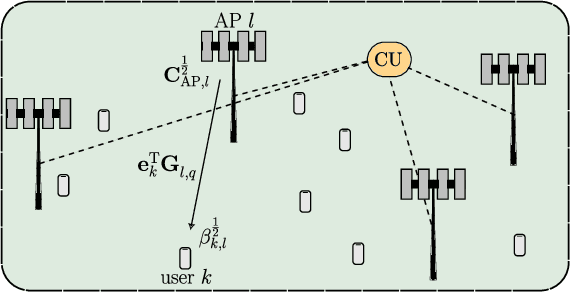

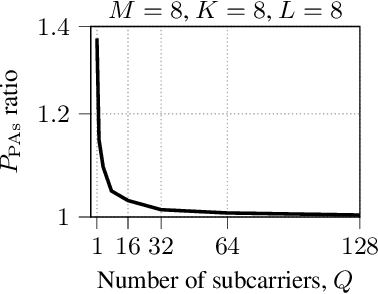
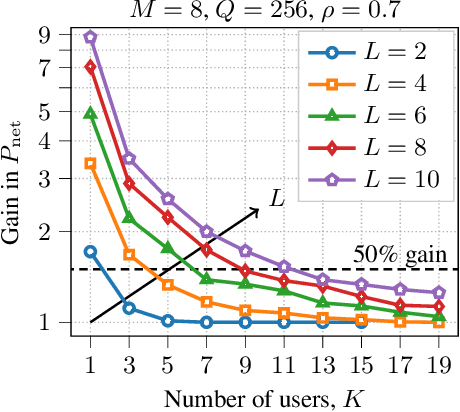
Abstract:We study cell-free massive multiple-input multiple-output precoders that minimize the power consumed by the power amplifiers subject to per-user per-subcarrier rate constraints. The power at each antenna is generally retrieved by solving a fixed-point equation that depends on the instantaneous channel coefficients. Using random matrix theory, we retrieve each antenna power as the solution to a fixed-point equation that depends only on the second-order statistics of the channel. Numerical simulations prove the accuracy of our asymptotic approximation and show how a subset of access points should be turned off to save power consumption, while all the antennas of the active access points are utilized with uniform power across them. This mechanism allows to save consumed power up to a factor of 9$\times$ in low-load scenarios.
Deep Unfolding for Fast Linear Massive MIMO Precoders under a PA Consumption Model
Apr 25, 2023Abstract:Massive multiple-input multiple-output (MIMO) precoders are typically designed by minimizing the transmit power subject to a quality-of-service (QoS) constraint. However, current sustainability goals incentivize more energy-efficient solutions and thus it is of paramount importance to minimize the consumed power directly. Minimizing the consumed power of the power amplifier (PA), one of the most consuming components, gives rise to a convex, non-differentiable optimization problem, which has been solved in the past using conventional convex solvers. Additionally, this problem can be solved using a proximal gradient descent (PGD) algorithm, which suffers from slow convergence. In this work, to overcome the slow convergence, a deep unfolded version of the algorithm is proposed, which can achieve close-to-optimal solutions in only 20 iterations compared to the 3500 plus iterations needed by the PGD algorithm. Results indicate that the deep unfolding algorithm is three orders of magnitude faster than a conventional convex solver and four orders of magnitude faster than the PGD.
Energy-Saving Precoder Design for Narrowband and Wideband Massive MIMO
Apr 04, 2023Abstract:In this work, we study massive multiple-input multiple-output (MIMO) precoders optimizing power consumption while achieving the users' rate requirements. We first characterize analytically the solutions for narrowband and wideband systems minimizing the power amplifiers (PAs) consumption in low system load, where the per-antenna power constraints are not binding. After, we focus on the asymptotic wideband regime. The power consumed by the whole base station (BS) and the high-load scenario are then also investigated. We obtain simple solutions, and the optimal strategy in the asymptotic case reduces to finding the optimal number of active antennas, relying on known precoders among the active antennas. Numerical results show that large savings in power consumption are achievable in the narrowband system by employing antenna selection, while all antennas need to be activated in the wideband system when considering only the PAs consumption, and this implies lower savings. When considering the overall BS power consumption and a large number of subcarriers, we show that significant savings are achievable in the low-load regime by using a subset of the BS antennas. While optimization based on transmit power pushes to activate all antennas, optimization based on consumed power activates a number of antennas proportional to the load.
Linear Precoder Design in Massive MIMO under Realistic Power Amplifier Consumption Constraint
Jun 15, 2022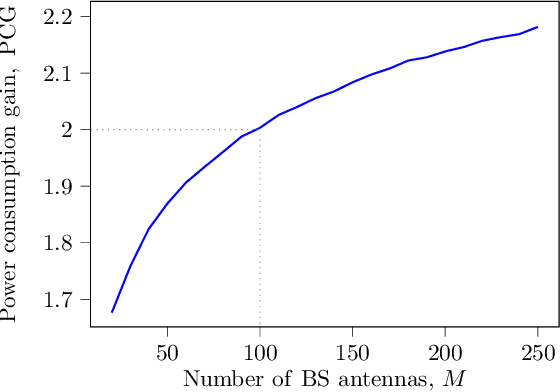
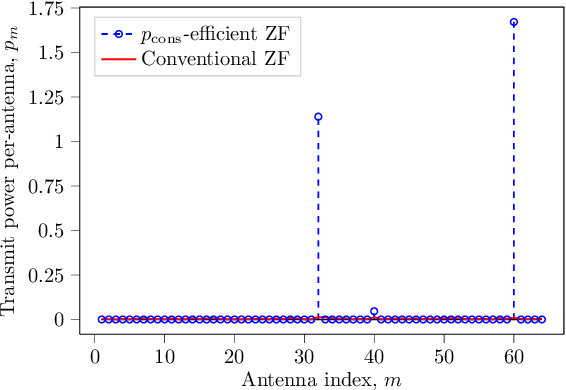
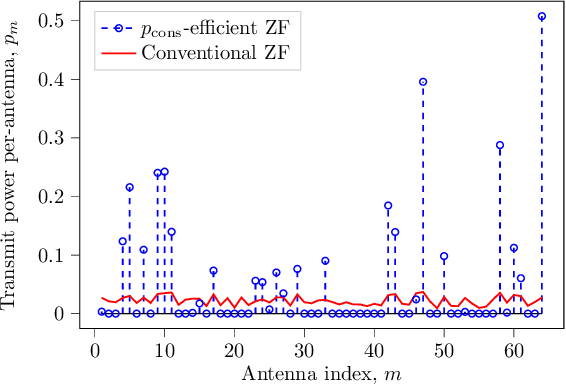
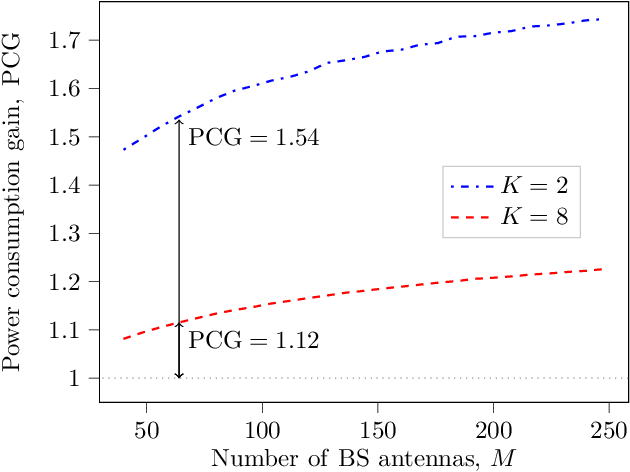
Abstract:The energy consumption of wireless networks is a growing concern. In massive MIMO systems, which are being increasingly deployed as part of the 5G roll-out, the power amplifiers in the base stations have a large impact in terms of power demands. Most of the current massive MIMO precoders are designed to minimize the transmit power. However, the efficiency of the power amplifiers depend on their operating regime with respect to their saturation regime, and the consumed power proves to be non-linearly related to the transmit power. Power consumption-based equivalents of maximum ratio transmission, zero-forcing, and regularized zero-forcing precoders are therefore proposed. We show how the structure of the solutions radically changes. While all antennas should be active in order to minimize the transmit power, we find on the contrary that a smaller number of antennas should be activated if the objective is the power consumed by the power amplifiers.
 Add to Chrome
Add to Chrome Add to Firefox
Add to Firefox Add to Edge
Add to Edge